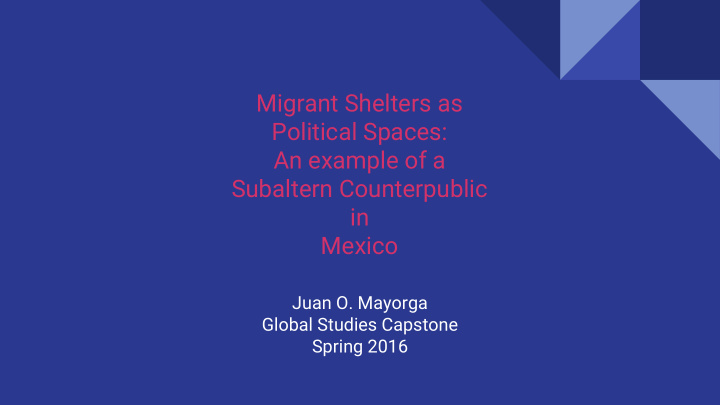



Migrant Shelters as Political Spaces: An example of a Subaltern Counterpublic in Mexico Juan O. Mayorga Global Studies Capstone Spring 2016
Introduction Undocumented Latin American ❏ migrants transit through Mexico Northern Triangle: Guatemala, ❏ Honduras, El Salvador Enter the U.S ❏ 2000 miles between Mexico’s ❏ Southern and Northern borders Freight Train “La Bestia” (The ❏ Beast)
Dangerous Route Migrants face the threat of ❏ robbery, kidnapping, extortion, and violence throughout the process (Frank-Vitale, 2013). Criminal groups, corrupt police, ❏ military, and INM agents. Plan Frontera Sur (Southern ❏ Border Plan) forcing migrants into higher risk areas to avoid detention and deportation.
Migrant Shelters Series of migrant shelters ❏ established to provide humanitarian support. Largely run by religious ❏ organizations, particularly Catholic church Food, water, medical and legal ❏ services
Undocumented Migration Project The Undocumented Migration Project is a long-term anthropological analysis of clandestine border crossings between Mexico and the U.S border directed by University of Michigan Anthropology Professor Dr. Jason De León. Carlos Alvarez Montero, The California Sunday magazine 6 week ethnographic study in Palenque, Chiapas and Tenosique, Tabasco Mexico. Are migrant shelters political spaces?
Theory: Subaltern Counterpublic Nancy Fraser (1997) writes that subaltern counterpublics are “parallel ❏ discursive arenas where members of subordinated social groups invent and circulate counter discourses” (p.81) These subaltern counterpublics permit subordinate groups to “...formulate ❏ oppositional interpretations of their identities, interest, and needs” (Fraser, 1997, p. 81). They function as spaces of withdrawal and regroupment, also as bases and ❏ training grounds for agitational activities directed toward wider publics They challenge the dominant public sphere (Governing & Political forces who ❏ create immigration policy)
Sanctuary Migrants shelters serve as subaltern ❏ counterpublics through the act of providing sanctuary. By providing a safe place to rest, transiting ❏ migrants can gather their strength to continue on their journey. Vasquez & Marquardt (2003) the act of providing ❏ John Doering-White, UMP, Sapiens sanctuary to transiting migrants can be seen as ways of resisting oppression and demoralization (p.159).
Challenging Government Rhetoric Plan Frontera Sur protecting the ❏ rights and safety of migrants transiting through Mexico? Increased crime, aggressive INM ❏ tactics Shelters provide a safe space to ❏ discuss issues with shelter staff, human rights defenders, and journalist who will bring them to the attention of the broader public www.chiapasparalelo.com
Civil Disobedience Shelters provide the resources to engage in acts of civil disobedience and allow migrants to engage in “agitational activities” that challenge the broader public. Viacrucis Migrante Leo Herrera Bankil, 2014
Conclusion As a Subaltern Counterpublic, migrant shelters are political spaces. They allow migrants to engage and challenge the broader public, despite being a “subordinate” group. OIM.org
Acknowledgments Special thanks to… Dr. Jason De Leon and the Undocumented Migration Project Migrant Shelters La 72 and Casa Del Caminante Jtatic Samuel Ruiz Garcia, in Tabasco and Chiapas Mexico. The Undergraduate Research Opportunity Center (UROC) Dr. Kathryn Poethig and Dr. Lorenzo Covarrubias for all the time and help they gave me.
References Bankil. (2014). Viacrucis Migrante 2014 | Voces Mesoamericanas. Retrieved May 09, 2016, from http://vocesmesoamericanas.org/2014/04/16/viacrucis-migrante-2014/ Cottrell, J. A. (2015, October 29). Way Station- Saturday Night at a Migrant Shelter in Southern Mexico. Retrieved April 20, 2016, from https://story.californiasunday.com/migrant-shelter-mexico-guatemala De Leon, J., Garcia, E., & The Undocumented Migration Project. (2016, February 16). A View From the Train Tracks - SAPIENS. Retrieved May 09, 2016, from http://www.sapiens.org/culture/prevention-through-deterrence/ El Plan Frontera Sur: Un año de represión, persecución y muerte. (2015, July 8). Retrieved May 09, 2016, from http://enelcamino.periodistasdeapie.org.mx/el-plan-frontera-sur-un-ano-de-represion-persecucion-y-muerte-2/ Frank-Vitale, A. (2013). Central American Migrants in Mexico: Implications for U.S. Security and Immigration Policy. SSRN Electronic Journal SSRN Journal, (2). Fraser, N. (1997). Justice interruptus: Critical reflections on the "postsocialist" condition . New York, NY: Routledge. Herrera, L. (2014). Vía-Crucis Migrante. La experiencia de la solidaridad y la desolación. Retrieved May 09, 2016, from https://elportaldehermes.wordpress.com/2014/09/07/via-crucis-migrante-la-experiencia-de-la-solidaridad-y-la-desolacion-galeria-de-imagenes/ Vásquez, M. A., & Marquardt, M. F. (2003). Globalizing the sacred: Religion across the Americas . New Brunswick, NJ: Rutgers University Press.
Recommend
More recommend